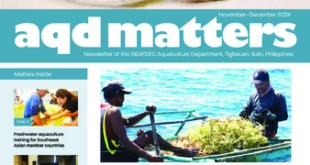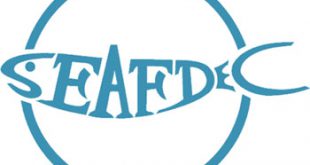Brief description: This new technology on shrimp farming in brackishwater ponds incorporates pollution management which constitutes 9% of annual shrimp production cost per ha of the farmer. Pollution management is worth the cost considering that a shrimp farmer could lose it all during a disease outbreak.
Environment-friendly practices include:
(1) Lowered stocking density ~ this may decrease harvest volume by 20-30% but the harvest value could increase by 8-10%due to bigger size and improved feed conversion. Feeding and nutrient loading is reduced by 20%, and the risk of opportunistic diseases is reduced as well.
(2) Improvement of pond bottom management ~ this may increase plowing or tilling cost, add netcage construction to the expense but these costs could be recovered from the sale of added fish crop. Bacterial profile of sediment is improved, however, as well as water effluent quality. The pathogenic Vibrio count is reduced.
(3) Crop rotation ~ one shrimp crop may be lost but there is some income from fish culture. Crop rotation improves sediment bacterial profile, reduces Vibrio count, reduces incidence of white spot, and ultimately allow time for organic waste to break down.
(4) Improvement in feed quality ~ SEAFDEC/AQD has formulated a diet much improved in nutritional quality and lower nitrogen and phosphorus discharges. Farmers may also use probiotics.
(5) Stocking of laboratory-screened fry ~ there is a cost to fry analysis and screening and waiting time for the results, but the farmer is reducing the risks for white spot and pathogenic Vibrio infections.
(6) Use of greenwater technology ~ culture area may be reduced by 25-50% due to the requirement for bigger reservoir but cost can be recovered from the sale of fishes raised in the reservoir. There is also added expense for modifying the water supply channel. The advantage is more stable water quality, and suppression of growth of pathogenic Vibrio.
(7) Use of probiotics in water and feed ~ this can add a cost of P20,000 to P40,000 per ha per crop but healthy, antibiotic- free shrimp is produced. Improved water quality and lower sludge accumulation are the benefits, in addition to reducing the risk of developing more virulent antibiotic-resistant strains of bacteria.
(8) Increase in aeration ~ addition of P150,000 to 200,000 per ha for aerators and 50-60% increase in power consumption but the shrimp grow faster and improve its feed conversion with increased dissolved oxygen levels and reduced noxious metabolites.
(9) Use of settling ponds ~ additional cost of P2,500 to 5,000 per ha per year but settling ponds lower load of suspended solids in effluent water and reduce the sediment accumulation in receiving waters.
(10) Employment of biosecurity measures ~ additional cost of P15,000 to 20,000 per ha per year for pond sanitation, carrier exclusion devices, filters, and worker hygiene but these measures significantly reduce the risk of introducing viral diseases to the pond facility.
| Technology profile: | |
| (1) Re-engineer the farm layout by providing a bigger reservoir; impounding a portion of the mangrove area near the ponds to where effluents may be held; and assigning sedimentation and biological treatment ponds containing fish, bivalves and seaweeds.
(2) Prepare the ponds. Drain totally. Level the pond bottom. Dig peripheral and central canals. Crack-dry. Remove the black sludge that accumulated in previous cropping. Flush the pond with water then drain. Apply either agricultural lime at 2 tons per ha or hydrated lime at 0.5 to 1 ton per ha. Till the pond bottom. Compact. Install the central and side sludge collectors. Install catwalks and feeding trays in grow-out ponds. Let in water. Position the aerators and the pumps. Apply teaseed powder at 50 kg per ha to kill predators and competitors. Apply dried chicken or cow manure at 300 kg per ha together with urea (45-0-0) at 18 kg per ha by the “tea bag” method. Fertilize again if necessary. (3) In the reservoir (25% of the grow-out farm), stock biomanipulators like all-male tilapia and milkfish at 5,000 to 10,000 fish per ha. Hold water for at least a week before using it in grow-out ponds. (4) In the grow-out ponds, acclimate then stock disease-free shrimp (at least postlarvae day 18) at 25 pieces per m2, which gives the highest net profit per ha of P1.8 million. Stocking lower at 15 pieces per m2 can get you P1.1 million; while stocking higher at 40 pieces per m2 gives only P0.6 million. Biomanipulators may be stocked inside walled net enclosures (10 x 10 x 1.5 m) that are placed in the middle of the grow-out ponds. These fishes can feed on the sludge that the paddle-wheel aerators tend to deposit at the center. The sides of the ponds may also be enclosed similarly and stocked with biomanipulators. (5) Follow the usual pond routine ~ feed according to the feed manufacturer’s instructions, sample stock regularly to adjust feeding demand, monitor water quality and bacterial populations regularly, keep complete records. If probiotics is an option, follow the application rate in the label. Operate the aerators from 6 pm to 6 am. (6) In the low discharge system, a small amount of water is discharged from the grow-out pond and released to the sea after passing through the settling or mangrove impoundment. To be effective, hold pond effluents in mangroves for 6 hours or more. (7) In the recirculating system, effluents from the grow-out pond are reused after passing through the treatment pond. Water is fully circulated by pumping twice, first from the head reservoir to the grow-out pond and then from the treatment pond to the grow-out pond. (8) In treatment ponds, the effluent from the grow-out ponds passes through several hurdles. Note that the main drain canal can serve as one of the treatment ponds. Install baffles to serve as mechanical filtration units and to settle suspended solids. Dissolved nutrients can be taken up by biofilters like oysters, the seaweed Gracilaria, and green mussel, and these are stocked in the treatment ponds. Finally, a filter box fitted with a 2 hp submersible pump is installed at the end of the pond. (9) Harvest in 4-5 months by totally draining the ponds. Chill and sort before packing shrimp. Average weight is at least 25 grams. |
|
References
Baliao DD. 2000. Environment-friendly schemes in intensive shrimp farming. State-of-the-Art series, SEAFDEC and ASEAN. 27 p
Baliao DD, Tookwinas S. 2002. Best management practices for a mangrove-friendly shrimp farming. Aquaculture Extension Manual No. 35, SEAFDEC Aquaculture Department. 51 p
de la Peña LD, Lavilla-Pitogo CR, Namikoshi A, Nishizawa T, Inui Y, Muroga K. 2003. Mortality in pond-cultured shrimp Penaeus monodon in the Philippines associated with Vibrio harveyi and white spot syndrome virus. Fish Pathology 38:59-61
Feed Development Section. 1994. Feeds and feeding of milkfish, Nile tilapia, Asian sea bass, and tiger shrimp. Aquaculture Extension Manual 21. SEAFDEC Aquaculture Department, Tigbauan, Iloilo. 97 p
Honculada-Primavera J. 1991. Intensive prawn farming in the Philippines – Ecological, social, and economic implications. Ambio 20:28-33
Honculada-Primavera J. 1993. A critical review of shrimp pond culture in the Philippines. Reviews in Fisheries Science 1:151-201
Honculada-Primavera J, Lavilla-Pitogo CR, Ladja JM, de la Peña MR. 1993. A survey of chemical and biological products used in intensive prawn farms in the Philippines. Marine Pollution Bulletin 26:35-40
Hatch U, Agbayani RF, Belleza E. 1996. Economic analysis of prawn (Penaeus monodon) culture in the Philippines, II: Grow-out operations. Asian Fisheries Science 9:127-141
Infotips on mangrove-friendly shrimp farming, 8-leaflet folder, undated. SEAFDEC and ASEAN
Lavilla-Pitogo CR, Lio-Po GD, Cruz-Lacierda ER, Alapide-Tendencia EV, de la Pena LD. 2000. Diseases of penaeid shrimps in the Philippines. Aquaculture Extension Manual No. 16, 2nd edition; SEAFDEC Aquaculture Department, Tigbauan, Iloilo. 83
Leaño EM, Lio-Po GD, Nadong LA, Tirado AC, Sadaba RB, Guanzon NG Jr.. 2005. Microflora of the “green water” culture system of tiger shrimp Penaeus monodon. Aquaculture Research 36:1581-1587
Lio-Po GD, Leaño EM, Peñaranda MMD, Villa-Franco AU, Sombito CD, Guanzon NG Jr. 2005. Anti-luminous Vibrio factors associated with the “green water” grow-out culture of the tiger shrimp Penaeus monodon. Aquaculture 250:1-7
Lio-Po GD, Lavilla-Pitogo CR, Cruz-Lacierda ER. 2001. Health management in aquaculture (textbook). SEAFDEC Aquaculture Department, Tigbauan, Iloilo. 187 p
Matsuura T, Salayo ND, Siar SV, Baticados DB, Primavera JH. 2004. Changes in farm management and production systems: Response to shrimp culture problems in the Philippines. Japan Regional Fisheries Society: Regional Fisheries Research 45:53-66
Primavera JH. 1997. Socio-economic impacts of shrimp culture (review). Aquaculture Research 28:815-827.
Primavera JH. 1998. Mangroves as nurseries: Shrimp populations in mangrove and non-mangrove habitats. Estuarine and Coastal Shelf Science 46:457-464
Samonte GPB, Agbayani RF, Tumaliuan RE. 1991. Economic feasibility of polyculture of tiger shrimp (Penaeus monodon) with Nile tilapia (Oreochromis niloticus) in brackishwater ponds. Asian Fisheries Science 4:335-343
Tendencia EA, de la Peña LD. 2001. Antibiotic resistance of bacteria from shrimp ponds. Aquaculture 195:193-204
Tendencia EA, de la Peña MR. 2003. Investigation of some components of the greenwater system which makes it effective in the initial control of luminous bacteria. Aquaculture 218:115-119
Tendencia EA, de la Peña MR, Choresca CH Jr.. 2005. Efficiency of Chlorella sp. and Tilapia hornorum in controlling the growth of luminous bacteria in a simulated shrimp culture environment. Aquaculture 249:55-62
Tendencia EA, de la Peña MR, Choresca CH Jr. 2006. Effect of shrimp biomass and feeding on the anti-Vibrio harveyi activity of Tilapia sp. in a simulated shrimp-tilapia polyculture system. Aquaculture 253:154-162
Tendencia EA, Fermin AC, de la Peña MR, Choresca CH Jr. 2006. Effect of Epinephelus coioides, Chanos chanos, and GIFT tilapia in polyculture with Penaeus monodon on the growth of the luminous bacteria. Aquaculture 253:48-56
Tookwinas S. 2000. Closed-recirculating shrimp farming system. State-of-the-Art series, SEAFDEC and ASEAN. 28 p
Xu ZK, Primavera JH, de la Peña LD, Pettit P, Belak J, Alcivar-Warren A. 2001. Genetic diversity of wild and cultured black tiger shrimp (Penaeus monodon) in the Philippines using microsatellites. Aquaculture 199:13-40.
 SEAFDEC/AQD Southeast Asian Fisheries Development Center | Aquaculture Department
SEAFDEC/AQD Southeast Asian Fisheries Development Center | Aquaculture Department


